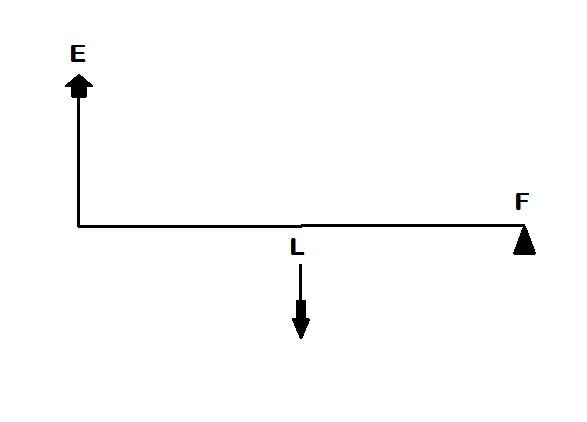
The diagram shows a lever in use. To which class of levers does it belong?


Answer
499.2k+ views
Hint:A lever is a simple machine consisting of a beam or rigid rod pivoted at a fixed hinge, or fulcrum. A lever is a rigid body capable of rotating on a point on itself. There are mainly three types of levers according to where the load and effort are located with respect to the fulcrum. Class 1 has the fulcrum placed between the effort and load. Class 2 has the load between the effort and the fulcrum. Class 3 has the effort is between the load and the fulcrum.
Complete step by step solution:
In the above figure E refers to the effort, L refers to the load and F refers to the fulcrum.
In levers Effort is the force applied at one point on the lever in order to move an object.
The object being moved by the lever is often called the load.
In levers fulcrum is a pivot point around which a lever turns or something that plays a central role in or is in the center of a situation or activity.
In class 2 levers the fulcrum lies at the end, the effort is applied at the other end, and the load is placed in the middle. The closer the load is to the fulcrum, the lesser amount of force is needed to lift the load. For example wheelbarrow and nutcracker.
Whereas in class 1 has the fulcrum placed between the effort and load and in class 3 the effort is between the load and the fulcrum.
Thus it is clear from the above that the given diagram is of class 2 lever.
Note: Sometimes the question might be tricked by changing names such as changing ‘effort’ to ‘force’ or ‘fulcrum’ to ‘pivot’ and many more, so one should not confuse with the names and be clear with all types of levers to avoid any confusion.
Complete step by step solution:
In the above figure E refers to the effort, L refers to the load and F refers to the fulcrum.
In levers Effort is the force applied at one point on the lever in order to move an object.
The object being moved by the lever is often called the load.
In levers fulcrum is a pivot point around which a lever turns or something that plays a central role in or is in the center of a situation or activity.
In class 2 levers the fulcrum lies at the end, the effort is applied at the other end, and the load is placed in the middle. The closer the load is to the fulcrum, the lesser amount of force is needed to lift the load. For example wheelbarrow and nutcracker.
Whereas in class 1 has the fulcrum placed between the effort and load and in class 3 the effort is between the load and the fulcrum.
Thus it is clear from the above that the given diagram is of class 2 lever.
Note: Sometimes the question might be tricked by changing names such as changing ‘effort’ to ‘force’ or ‘fulcrum’ to ‘pivot’ and many more, so one should not confuse with the names and be clear with all types of levers to avoid any confusion.
Recently Updated Pages
Master Class 11 Business Studies: Engaging Questions & Answers for Success

Master Class 11 Accountancy: Engaging Questions & Answers for Success

Master Class 11 Computer Science: Engaging Questions & Answers for Success

Master Class 11 English: Engaging Questions & Answers for Success

Master Class 11 Social Science: Engaging Questions & Answers for Success

Master Class 11 Economics: Engaging Questions & Answers for Success

Trending doubts
Which one is a true fish A Jellyfish B Starfish C Dogfish class 11 biology CBSE

State and prove Bernoullis theorem class 11 physics CBSE

1 ton equals to A 100 kg B 1000 kg C 10 kg D 10000 class 11 physics CBSE

In which part of the body the blood is purified oxygenation class 11 biology CBSE

One Metric ton is equal to kg A 10000 B 1000 C 100 class 11 physics CBSE

Difference Between Prokaryotic Cells and Eukaryotic Cells




